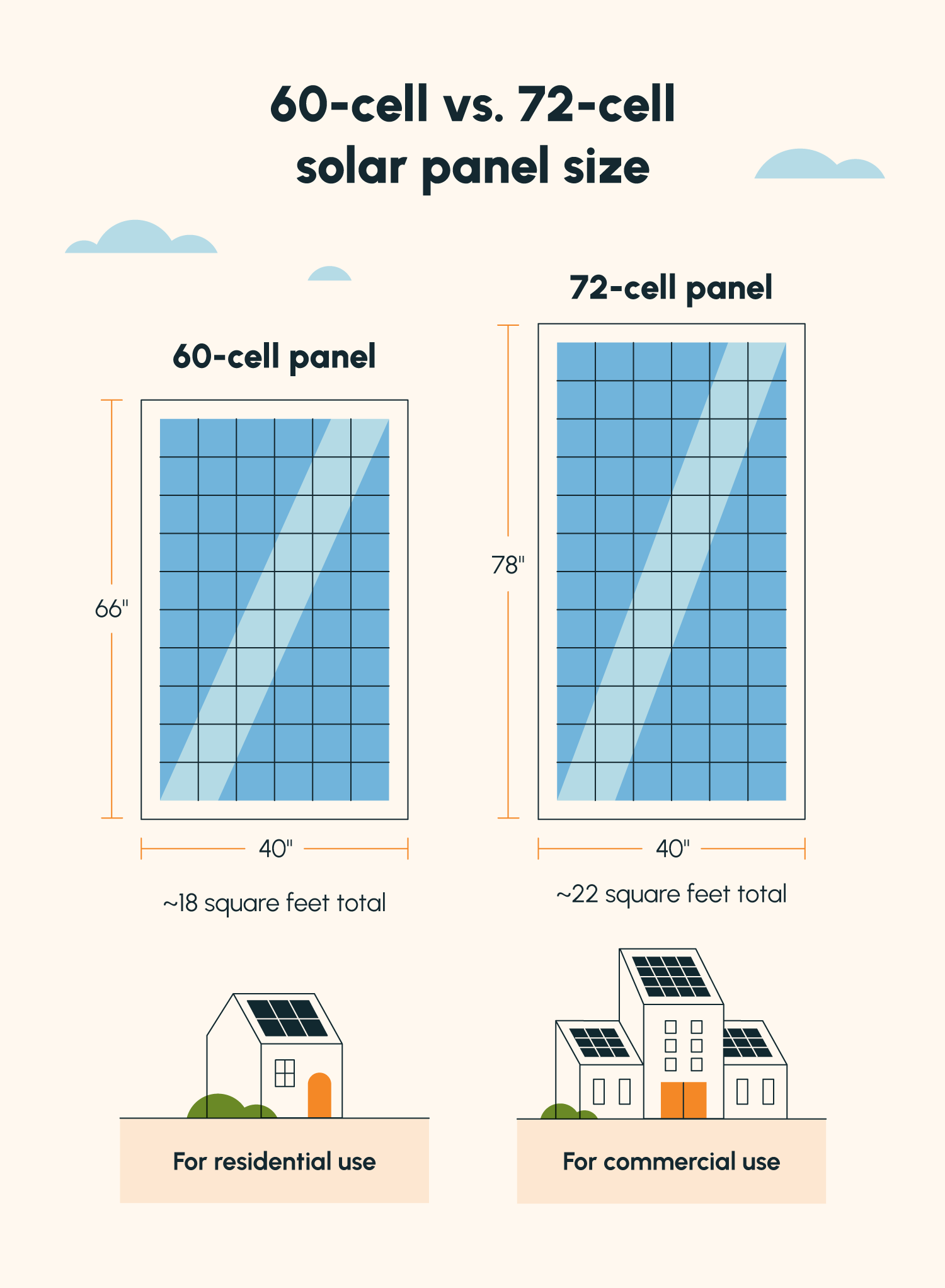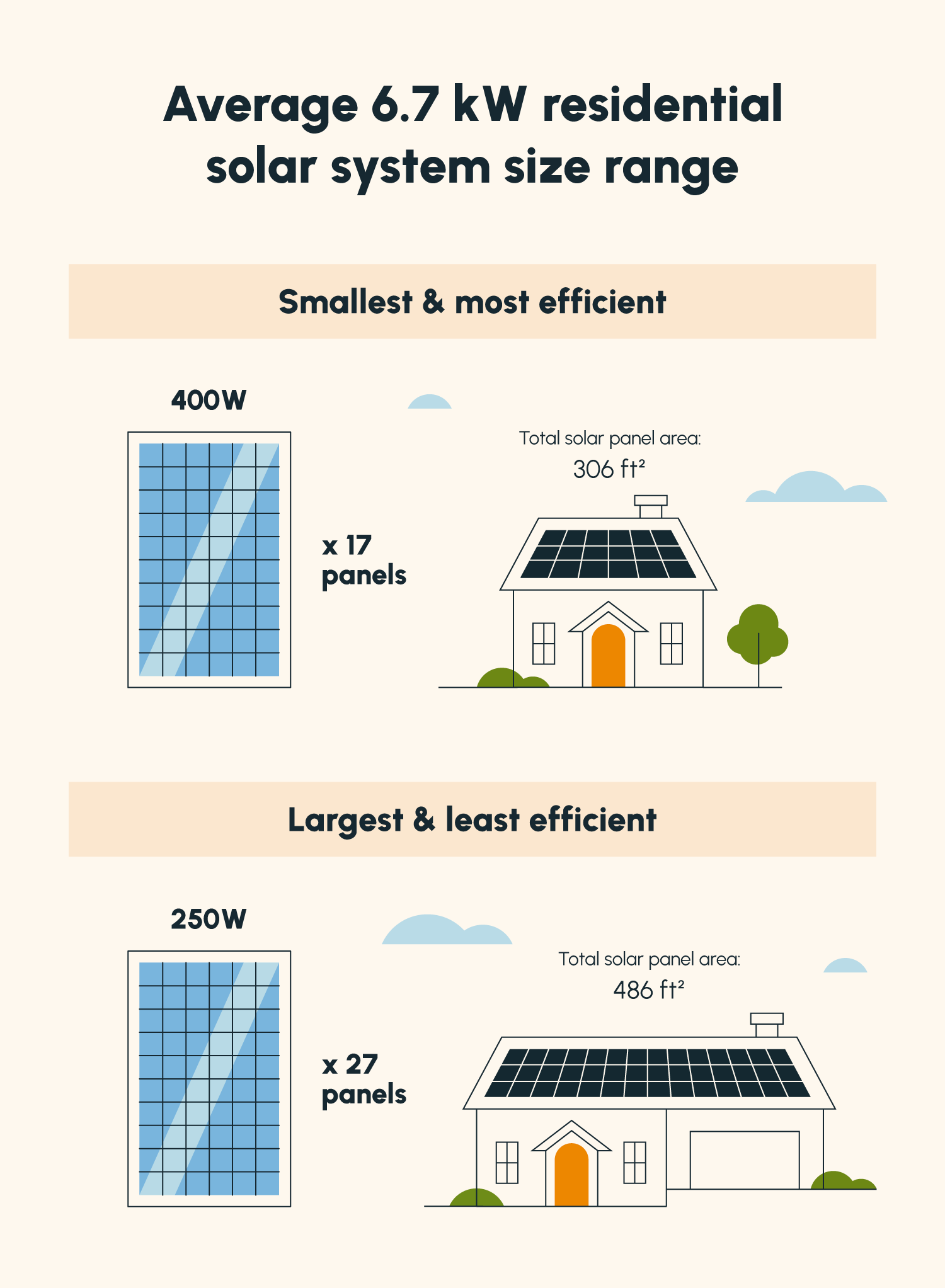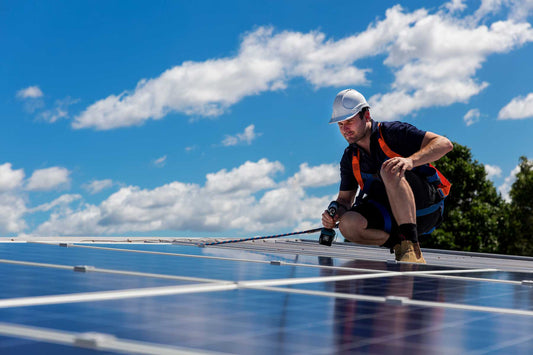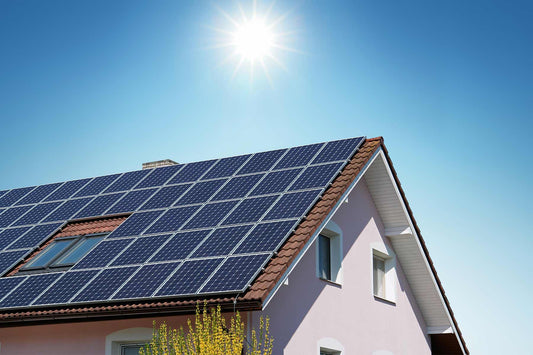While it varies by manufacturer, most solar panels are about 66 inches by 40 inches, or a little over 5 feet by 3 feet.
Picture this — after determining the solar system size you need and ordering enough panels to support your electricity consumption, you find that you don’t have enough space on your roof to support them. Uh-oh.
As sleek and powerful as solar panels are, they still take up considerable space. That’s why it’s important to first understand solar panel size and do some math before determining how many solar panels you can fit on your property.
Most solar panels are a little over 5 feet by 3 feet and weigh 40-45 pounds, but size varies by manufacturer.
In this guide, we’ll unpack solar panel size in greater detail, helping you determine how large of a system your property can accommodate before you purchase your panels.
Average Solar Panel Dimensions

Standard residential solar panels measure 66 inches by 40 inches, or a little over 5 feet long and 3 feet wide. Each panel therefore takes up around 18 square feet. Commercial panels tend to be a bit bigger than residential panels, averaging about 6.5 feet long.
Solar panel dimensions depend on how many cells are in each panel, as cell size is pretty uniform across all brands of residential solar panels. Each cell is usually 156 millimeters by 156 millimeters, or 6 inches long and 6 inches wide.
Residential panels usually contain 60 cells each, whereas commercial panels usually contain 72 cells or more. Refer to the solar panel size chart below for a comparison of average residential and commercial solar panel dimensions.
| Quality | Residential panels | Commercial panels |
|---|---|---|
| Solar cells | 60 | 72 |
| Length (inches) | 66 | 78 |
| Width (inches) | 40 | 40 |
| Area (square feet) | 17 - 18 | 21 - 22 |
| Depth (inches) | 1.5 - 2 | 1.5 - 2 |
Determining Solar Array Size
The average U.S. residential utility customer uses 893 kWh per month. To completely offset this usage, the average American would need a 6.7 kW solar panel system.
Most solar panels have an output rating between 250 W and 400 W. Let’s calculate how many panels (and how much space) are needed for a 6.7 kW (6,700 W) system based on various panel output ratings:
- 6,700 W / 250 W = 26.8 (27 panels)
- 27 panels x 18 sq. ft. = 486 sq. ft.
- 6,700 W / 300 W = 22.3 (23 panels)
- 23 panels x 18 sq. ft. = 414 sq. ft.
- 6,700 W / 350 W = 19.1 (20 panels)
- 20 panels x 18 sq. ft. = 360 sq. ft.
- 6,700 W / 400 W = 16.75 (17 panels)
- 17 panels x 18 sq. ft. = 306 sq. ft.
As you can see, the higher your panels’ efficiency, the fewer panels you’ll need to power your home. If you don’t have enough space on your roof (or on the ground) for a less efficient system that requires more panels, aim for panels with a higher output.

When determining whether your roof has enough space to support an entire solar system, remember to take into consideration the direction your roof is facing. Ideally, your panels will face true south or slightly southwest, as this will maximize your panels’ output.
If you don’t have enough optimally positioned roof space, you may need to settle for a smaller system that doesn’t totally offset your energy usage or purchase additional panels to place on suboptimal parts of your roof.
Average Solar Panel Weight

In addition to panel dimensions, you might be asking, “How much do solar panels weigh?” Weight is an important consideration when lifting, transporting, and installing your panels.
The average residential solar panel weighs 40-45 pounds, though weight varies by manufacturer and can be as heavy as 60 pounds. While theoretically this shouldn’t be too heavy for one person to lift, their size can make them awkward to carry.
Very few residential solar systems are larger than 10 kW (about 31 panels), so let’s consider how heavy a system of this size would be. Multiply 31 panels by 45 pounds and you get 1,395 pounds.
Can Your Roof Support a Solar Panel System?
| System size | Number of 325 W panels | Weight |
|---|---|---|
| 3 kW | 10 | 450 lbs |
| 6 kW | 19 | 855 lbs |
| 10 kW | 31 | 1,395 lbs |
| 15 kW | 47 | 2,115 lbs |
If you’re at all concerned about the weight of solar panels on your roof — specifically, whether your roof can support an entire solar system — don’t fret.
Most modern roofs can support much more weight than a solar system. In fact, a shingled roof should be able to support 20 pounds per square foot and a clay tile or metal roof should support 27 pounds per square foot.
With most solar panels distributing 40-45 pounds of weight across 18 square feet (about 2.5 pounds per square foot), your roof should be able to easily support an entire solar system.
That said, if your roof is very old or there’s another reason you aren’t confident in its structural integrity, consider contacting a roofing company to inspect your roof and confirm that it will support a solar system.
Monocrystalline vs. Polycrystalline Solar Panel Dimensions & Weight
There are two types of solar panels used to power most homes — monocrystalline and polycrystalline. They tend to have a slightly different weight and size since each is made differently.
Monocrystalline solar cells are cut from a pure silicon crystal, whereas polycrystalline solar cells are made with small bits of silicon that have been melted and cut into sheets.
Monocrystalline panels, being more efficient with less material, are smaller and weigh less than polycrystalline panels. Generally, polycrystalline panels weigh 2-5 pounds more and are about a square foot larger than monocrystalline panels.
Overall, this size difference is pretty negligible and shouldn’t pose an issue when calculating how many panels you can fit on your roof.
Solar Panel Size FAQ
Every home has limited available space for solar panels, so panel size is a very important consideration when planning out your system. We address some frequent questions about solar panel dimensions and weight below.
How Big Is a Solar Panel?
While it varies based on manufacturer, most residential solar panels are about 66 inches by 40 inches, or a little over 5 feet by 3 feet. This comes out to about 18 square feet.
Commercial solar panels tend to run a bit bigger at 6.5 feet long on average (occupying about 21 square feet).
How Big Are Portable and RV Solar Panels?
Portable and RV solar panels vary in size significantly depending on their type, wattage, and manufacturer.
5 W portable panels tend to be under 1 square foot, while 200 W RV panels are comparable in size to residential panels at about 14 square feet. Explore our portable and RV panels to find a size and wattage that fits your needs.
How Heavy Are Solar Panels?
Residential solar panels usually weigh between 40 and 45 pounds, whereas commercial solar panels tend to weigh more — closer to 60 pounds.
How Big Is a 10 kW Solar System?
An average 10 kW solar system will take up about 525 square feet and weigh 1,350 pounds.
A 10 kW system requires about 30 panels. Since the average residential solar panel weighs about 45 pounds and occupies about 18 square feet, the following calculations can be used to determine the approximate size and weight of a 10 kW solar system:
- Size: 30 panels x 18 square feet = 540 square feet
- Weight: 30 panels x 45 pounds = 1,350 pounds
How Big Is a 300 W Solar Panel?
Most 300 W solar panels are about 66 inches long by 40 inches wide (about 18 square feet total) and weigh 40-45 pounds.
At Solartap, we understand the challenge of fitting an entire solar panel system on your property. That’s why we offer high-output options so that you can reduce the number of panels on your roof. The best part? They’re significantly cheaper than the competition.
Once you size your system and identify how much space you have available for panels, get a quote using our solar calculator today.




